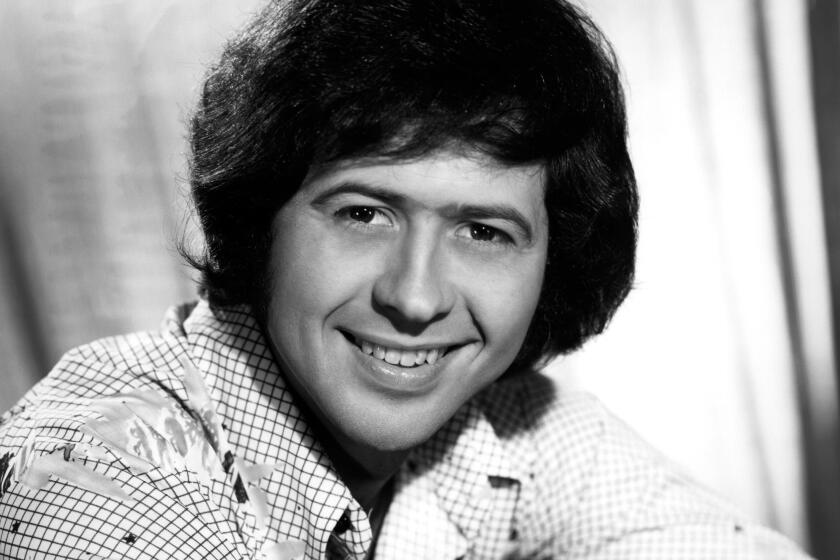Rosemary Clooney, 74; Legendary Singer
Rosemary Clooney, the versatile pop singer who soared to fame in the early 1950s with the novelty tune “Come On-a My House,” overcame prescription-pill addiction and a nervous breakdown in the late ‘60s and began a comeback in the late ‘70s that boosted her stature as one of the finest pop singers in show business, has died. She was 74.
Clooney, who had undergone surgery for lung cancer in January at the Mayo Clinic in Rochester, Minn., died Saturday night at her home in Beverly Hills with her family at her bedside.
For the record:
12:00 a.m. July 5, 2002 For The Record
Los Angeles Times Friday July 05, 2002 Home Edition Main News Part A Page 2 National Desk 5 inches; 210 words Type of Material: Correction
Rosemary Clooney album--An obituary Sunday about singer Rosemary Clooney contained an album title that was not accurate. The correct title is “Everything’s Coming Up Rosie.”
Known for her warm, velvety voice, Clooney was once described by Frank Sinatra as “a symbol of modern American music.”
But since her comeback, a time in which she recorded a series of tributes to songwriters such as Harold Arlen, Cole Porter and Duke Ellington on the Concord Jazz label, she matured into what jazz critic Don Heckman called “a lot more than a symbol, and a far more intriguing singer than she was during her ‘Come On-a My House’ days in the ‘50s.”
“Clooney’s voice,” Heckman wrote in 2000, “has been one of the natural wonders--too often underappreciated--since her pop star days in the ‘50s. And her turn toward jazz in recent decades has simply been a matter of bringing to the surface rhythmic qualities that were always a subtext in her singing.”
A reviewer for the New York Times once wrote of the recent-vintage Clooney that she was as “mellow as mature wine ... she brings a naturalness, solidity and unpretentious personal honesty to whatever she sings.”
Or as director Mike Nichols put it: “She sings like Spencer Tracy acts.”
“Her music was an extraordinary extension of this joyful soul,” her longtime friend, the singer and pianist Michael Feinstein, said Saturday night. “She was an earth mother, a heart person, and that quality came through in her music.”
Feinstein, who worked with Clooney numerous times over the years, recalled one engagement at the Hollywood Bowl. They were both nervous, Feinstein said, and he expected her to give him words of wisdom, but she turned to him and said, “Don’t think this ever gets any easier.”
“And with that, she went on stage.”
Clooney was born May 23, 1928, in Maysville, Ky. Her parents separated frequently and her father, a heavy drinker, was rarely around. Clooney, along with younger brother Nick--the father of actor George Clooney--and younger sister Betty, lived with various relatives.
Clooney began singing at age 3. At 5, she and her 2-year-old sister were singing together at home and in the car.
Their grandfather, Andrew Clooney, a jeweler who served on the city council and was a one-term elected mayor of Maysville, featured the girls as entertainers at his political rallies.
“We would sing on street corners, anywhere we could collect a crowd,” Clooney told The Times in 1988. “Betty had a natural gift for harmony. Her voice was lower than mine.” In 1941, when Rosemary was 13, the family moved to Cincinnati to live with Clooney’s maternal grandparents. Her mother later moved to California to marry a sailor, taking Nick with her.
In 1945, 16-year-old Rosemary and 13-year-old Betty auditioned for Cincinnati radio station WLW and were hired to sing duets on a nightly radio show for $20 a week apiece.
The Clooney Sisters were soon singing with local bands as well, and in 1946 big band leader Tony Pastor hired them to tour with his band as featured vocalists. Because of the girls’ young ages, their grandmother sent their uncle on the road with them as chaperon.
Clooney made her first solo record in 1946, “I’m Sorry I Didn’t Say I’m Sorry When I Made You Cry Last Night.”
After three years of touring mostly one-night stands, Betty quit the band and Rosemary remained as a soloist.
But in 1949, Clooney struck out on her own, and in 1950 she signed a recording contract with Columbia Records. She initially achieved some success with children’s songs such as “Me and My Teddy Bear” and “Little Johnny Chickadee” and in 1951 scored a minor hit with “Beautiful Brown Eyes.”
But then came the unexpected hit that would make her a household name.
In June 1951, Columbia’s head of artists and repertoire, Mitch Miller, told Clooney she’d be recording “Come On-a My House,” a quasi-Armenian folk song written by an unlikely duo: author William Saroyan and Ross Bagdasarian, who, as David Seville, later created the singing Chipmunks.
Clooney balked at singing--in a fake accent that sounded more Italian than Armenian--what she considered a “dumb” song with lyrics that “sounded more like a drunken chant than an historic folk art form.” She also hated the “gimmicky” arrangement: It was orchestrated for an amplified harpsichord.
When she told Miller she wouldn’t do it, she recalled in her 1977 autobiography “This for Remembrance,” Miller responded by saying, “Well, let me put it this way. I will fire you unless you show up tomorrow.”
The savvy Miller’s instincts proved correct. Within weeks, Clooney had one of the biggest-selling songs in the country and “Come On-a My House” went on to sell more than a million copies.
Over the next four years, Clooney amassed a string of hits, including “Tenderly” (a No. 1 tune that became her theme song), “Half as Much,” “Botch-a-me,” “Too Old to Cut The Mustard” (a duet with Marlene Dietrich), “The Night Before Christmas Song” (with Gene Autry), “Hey There,” “This Ole House,” and “Mambo Italiano.”
With her recording success, Hollywood naturally came calling.
As Paramount’s latest “girl next door,” the blond, blue-eyed Clooney made her motion picture debut in 1953 in “The Stars Are Singing,” a largely forgettable musical. She made five movies in quick succession, including her most memorable film, “White Christmas” with Bing Crosby and Danny Kaye, but her film career never took off.
Of course, as Clooney once joked, “They weren’t writing lead roles for pregnant women.”
She had married actor Jose Ferrer, who was 16 years her senior, in 1953. And, beginning in 1955, she gave birth to five children in five years.
Clooney continued working, however. She hosted “The Rosemary Clooney Show,” a syndicated half-hour show in the 1955-’56 season, and appeared frequently on television variety shows--guest shots in which her frequent pregnancies prompted Bob Hope to quip that “Rosie’s favorite game is Vatican Roulette” and Tennessee Ernie Ford to insist, “You’ve got to find out what’s causing this.”
Clooney and Ferrer seemed to have it all: a huge house in Beverly Hills once owned by George Gershwin (Ira Gershwin remained their next-door neighbor), a glamorous life and celebrity friends. There were star-studded parties and dinners, after which frequent guest Nat “King” Cole would invariably stand up as the table was being cleared and say, “How about a little music for dessert?”
But Clooney’s marriage to Ferrer was troubled from the start and ended in divorce in 1961. They remarried the same year but divorced again in 1967.
By 1968, Clooney’s relationship with a younger man had ended, and, fighting depression, she became addicted to sleeping pills and tranquilizers.
A friend of Sen. Robert F. Kennedy’s, she was at the Ambassador Hotel that June when Kennedy was assassinated, triggering what became a complete mental breakdown.
During an engagement in Reno in July, she was so unstable that she walked off the stage during a performance and, as she has recounted, later found herself driving her car on the wrong side of the road on a two-lane mountain highway, playing a form of Russian roulette with oncoming cars and saying, “That’s one for you, God,” as approaching cars narrowly avoided hitting her.
Shortly thereafter, she was admitted to the psychiatric ward at a hospital in Los Angeles. Once released, she found herself working lounges in Holidays Inns in places like Ventura and Hawthorne.
“I didn’t mind it--the people were still there and it kept me going,” she told the Washington Post in 1992.
In the ‘70s, as she slowly rebuilt her personal and professional life, Clooney appeared in a series of commercials for a paper towel company, which had chosen her as spokeswoman after a survey showed that consumers trusted her.
In 1976, longtime friend Bing Crosby asked Clooney to join him on his 50th anniversary tour, but the turning point in her career came a year later when she signed with the small Concord Jazz label. The year she turned 50, Concord released what she later referred to as “the debut album of my new career: ‘Everything’s Coming Up Rose.’ ”
Over the next decade, Clooney emerged as what the New York Times called “an icon of classical pop and jazz,” a singer whose name, according to the Wall Street Journal, came to be “spoken in the same breath as Sinatra and Ella Fitzgerald.”
In 1982, a TV movie, “Rosie: The Rosemary Clooney Story,” was released with Sondra Locke portraying her.
In the 1990s, with Clooney now in her 60s, a series of career highs came her way.
In 1991, she made her debut at Carnegie Hall with a tribute to “Arrangers,” and she returned two years later with an equally acclaimed tribute to Bing Crosby. In 1994, she was nominated for an Emmy for outstanding guest actress in a drama series for her role as an Alzheimer’s patient given to belting out songs without warning on NBC’s “ER,” starring nephew George.
In 1996, she achieved her first No. 1 album, “Rosemary Clooney’s White Christmas,” which topped the jazz charts for three weeks.
Throughout the decade, Clooney was frequently nominated for Grammy awards in the traditional pop category. She also continued to appear in concert halls and clubs around the country, including an annual engagement at the preeminent cabaret room, Rainbows and Stars in New York City.
Although age had compromised some of her vocal ability, she said it enhanced other aspects. “I’ve lost some on top, but my lower register is better, and I think my expression is better,” she said in 1997. “I’m now filtering the songs I sing through a 68-year-old sensibility; I understand more and my interpretation is better.”
And, she said, she felt she still had something to offer audiences.
Invariably, she continued to receive requests to sing that “terrible” song, “Come On-a My House.”
“I can usually squirm out of it,” she said a few years ago. “But it gets worse. People ask me to sing [‘How much Is That] Doggie in the Window?’ which wasn’t even my song. It was Patti Page’s.”
With a throaty laugh, she added, “I just hope she gets asked plenty of times to sing ‘Come On-a My House.’ ”
Clooney is survived by her husband, Dante DiPaolo; five children from her marriage to Ferrer, Miguel Ferrer, Maria Murdoch, Gabriel Ferrer, Monsita Botwick and Rafael Ferrer; 10 grandchildren; her brother, Nick Clooney, and sister, Gail Clooney Darley.
The family asks that any donations be made to the Rosemary Clooney Fund for Support of Pulmonary Research, c/o Mayo Clinic, Rochester, Minnesota 55905. Services will be held in Beverly Hills and Kentucky and are pending.
*
Times staff writer Anna Gorman contributed to this story.
More to Read
The biggest entertainment stories
Get our big stories about Hollywood, film, television, music, arts, culture and more right in your inbox as soon as they publish.
You may occasionally receive promotional content from the Los Angeles Times.









